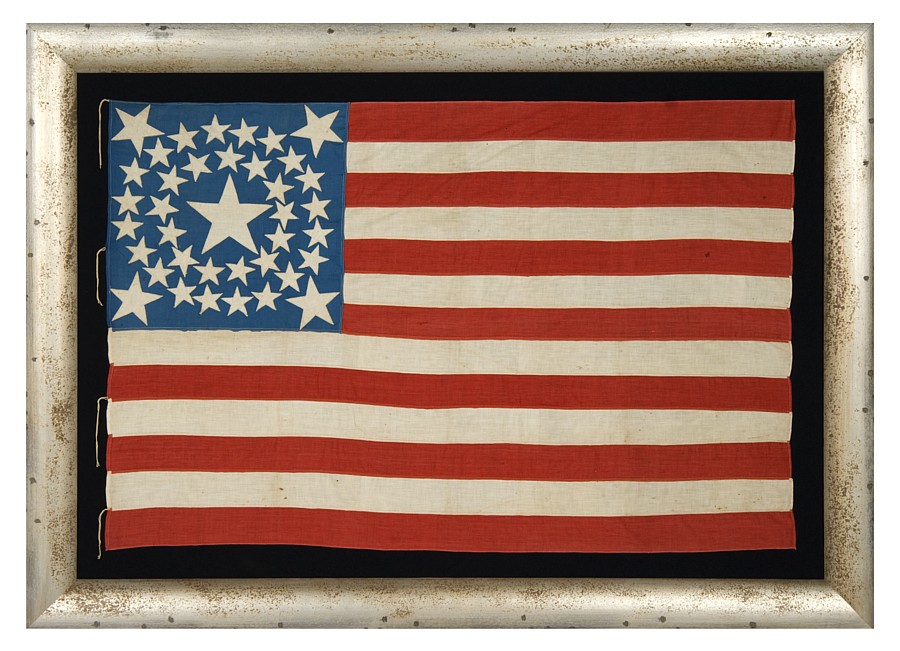
| |
38 STARS IN A DOUBLE-WREATH WITH A HUGE CENTER STAR, WITH A BRILLIANT ROYAL BLUE CANTON, ON A SEWN FLAG WITH ESPECIALLY SMALL SCALE FOR THE 19TH CENTURY, 1876-1889, COLORADO STATEHOOD |
|
| Available: |
Sold |
| Frame Size (H x L): |
49" x 68" |
| Flag Size (H x L): |
36.5" x 55.5" |
|
| Description....: |
|
38 STARS IN A DOUBLE-WREATH WITH A HUGE CENTER STAR, WITH A BRILLIANT ROYAL BLUE CANTON, ON A SEWN FLAG WITH ESPECIALLY SMALL SCALE FOR THE 19TH CENTURY, 1876-1889, COLORADO STATEHOOD:
38 star American national flag in a rare and wonderful small scale for the 19th century, with an especially dynamic double-wreath star configuration that features an unusually huge center star and a large star flanking in each corner of its brilliant, royal blue canton.
During the 19th century, flags with pieced and sewn construction (as opposed to printed) were typically eight feet long or larger. This is because they were important in their function as signals, meaning that they needed to be seen and recognized from a great distance. Even flags made for a more decorative purpose, such as this one, were generally very large by today's standards. A small flag was six feet in length. The making of sewn flags smaller than six feet, such as this example, was extremely limited, not only in commercial settings, but also among homemade examples. Since the average 19th century sewn flag can be cumbersome to frame and display in an indoor setting, many collectors prefer printed parade flags and smaller sewn flags, like this one, the size of which provides a good balance between visual impact and versatility.
The combination of strong color, bold graphics, and small size result in an especially desirable example.
The 38th state, Colorado, joined the Union on August 1st, 1876. This was the year of our nation's centennial of independence from Great Britain. Although 37 was the official star count in 1876, flag-making was a competitive venture and no one wanted to be making 37 star flags when others were making 38's. It is for this reason that 38 and 13 (to reference the original 13 colonies) are the two star counts most often seen during the centennial events.
The 38 star flag was generally used until 1889, when four new states joined the Union. Decorative star patterns, however, like this one, tend to be seen on 38 star flags that were made specifically for 1876 events, such as the Centennial International Exposition in Philadelphia, a six-month long, World's Fair event, held in conjunction with the nation's anniversary.
Construction: The fabric is entirely of broadcloth cotton. The flag is sewn entirely treadle-sewn using a combination of lineal and chain stitching. The chain used here saw very limited use. It is primarily seen in flags made during the closing two years of the Civil War. It's highly unusual to find the stitch in a flag of the centennial era of afterwards, but its presence in a later textile isn't unheard of. The stars are single-appliqued, which means that they were applied to one side of the canton, then the blue fabric was cut from behind each star, folded over, and under-hemmed, so that one star could be viewed on both sides of the flag. Some flag enthusiasts have pointed to this construction method as a way of conserving fabric--a logical explanation in early America, where availability of materials and logistics were constant barriers--while others suggest that the real purpose was to make the flag lighter in weight. Whatever the case may be, I always find single-appliqued stars more intriguing because they are evidence of a more difficult level of seam-work and stitchery. Four lengths of braided cotton cord have been hand-stitched along the hoist end so that the flag could be affixed to a staff.
Mounting: The flag was stitched to 100% silk organza on every seam and throughout the star field for support. It was then sewn to a background of 100% cotton twill, black in color, which was washed to remove excess dye. An acid-free agent was added to the wash to further set the dye and the fabric was heat-treated for the same purpose. The mount was then placed in a black-painted, hand-gilded and distressed Italian molding. The front is U.V. protective acrylic.
Condition: There is a scattering of very minor stains and tiny holes. The flag is in excellent condition for the period, scoring as near to a 10-out-of-10 as can be expected of any example. |
|
|
|
| Collector Level: |
Advanced Collectors and the Person with Everything |
|
| Flag Type: |
Sewn flag |
|
| Star Count: |
38 |
|
| Earliest Date of Origin: |
1876 |
|
| Latest Date of Origin: |
1889 |
|
| State/Affiliation: |
Colorado |
|
| War Association: |
1866-1890 Indian Wars |
|
| Price: |
SOLD |
|
| |
Views: 3228 |
|
|
|

